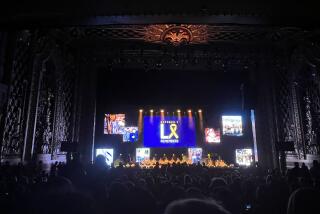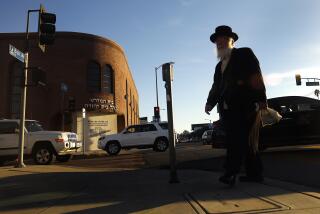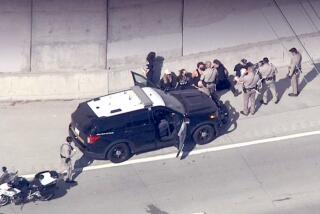Beverly Hills Under Fire for Allowing Menorah Rite
The American Jewish Congress has accused the City of Beverly Hills of violating the constitutional requirement for separation of church and state by allowing the ceremonial lighting of a 27-foot menorah two weeks ago at a city park.
As many as 3,000 people crowded into Beverly Gardens Park to witness the lighting of the menorah Dec. 29 during Hanukkah. City Councilman Maxwell Salter served as master of ceremonies and assisted in the lighting.
Former Beverly Hills Mayor George Slaff and Miriam Krinsky, an attorney representing the American Jewish Congress, went before the City Council last Tuesday and accused the city of violating the constitutional separation of church and state because it allowed the lighting to take place on public property.
Slaff and Krinsky said they hope to persuade the City Council to block ceremonies on municipal property next year.
Salter and others on the council said they saw nothing wrong with the ceremony. “I regard the menorah as a symbol of freedom for all people, not just Jews,” he said.
Marshall Grossman, an attorney representing Chabad Lubavitch, the Orthodox Jewish group that put up the Beverly Hills menorah, said the congress was unfairly singling out the Jewish holiday.
‘Jewish Revival Meeting’
Said Grossman: “One does not have to be Christian to look upon a Christmas tree as a symbol for peace and hope for mankind, and one does not have to be Jewish to bask in the warmth of a lit menorah and appreciate what it represents against oppression.”
Slaff, who attended the Beverly Hills ceremony, said the event was distinctly religious.
“I thought it was something like a Jewish revival meeting,” Slaff said. “Every male person on the platform wore a cap, hat or yarmulke. The fact that this took place on public land is a gross violation. It makes it appear that the city was taking part in the religious ceremony . . . breaking down the well-known walls of separation of church and state that the First Amendment was designed to cover.”
The congress and the American Civil Liberties Union have challenged the placing of menorahs and Nativity scenes on public property because doing so violates the law by giving “a seal of approval on a religion,” Krinsky said.
She said the American Jewish Congress has been criticized by the Jewish community for its stand. “There are those in the Jewish community who have been upset, but our position has been that we are against all religious displays on public property,” she said.
The congress filed papers in court last month supporting legal challenges by the ACLU against similar displays last month at Los Angeles City Hall and in Santa Ana.
But Los Angeles Superior Court Judge Robert H. O’Brien last month allowed the unlighted menorah to be displayed inside City Hall. He ruled that the menorah, which was rescued during the Holocaust, “presents . . . a visual display of history and culture,” and has cultural and educational value beyond its role as a religious symbol. In Santa Ana, a court ruling upheld the city’s right to allow candle-lighting ceremonies in a public park while refusing to allow the menorah to remain overnight.
Hanukkah celebrates the successful Jewish revolt against the Syrians in 165 BC. According to traditional Jewish lore, the eight branches of the menorah represent the eight days that the temple lamp burned when there was only enough sacred oil for one day.
More to Read
Sign up for Essential California
The most important California stories and recommendations in your inbox every morning.
You may occasionally receive promotional content from the Los Angeles Times.










